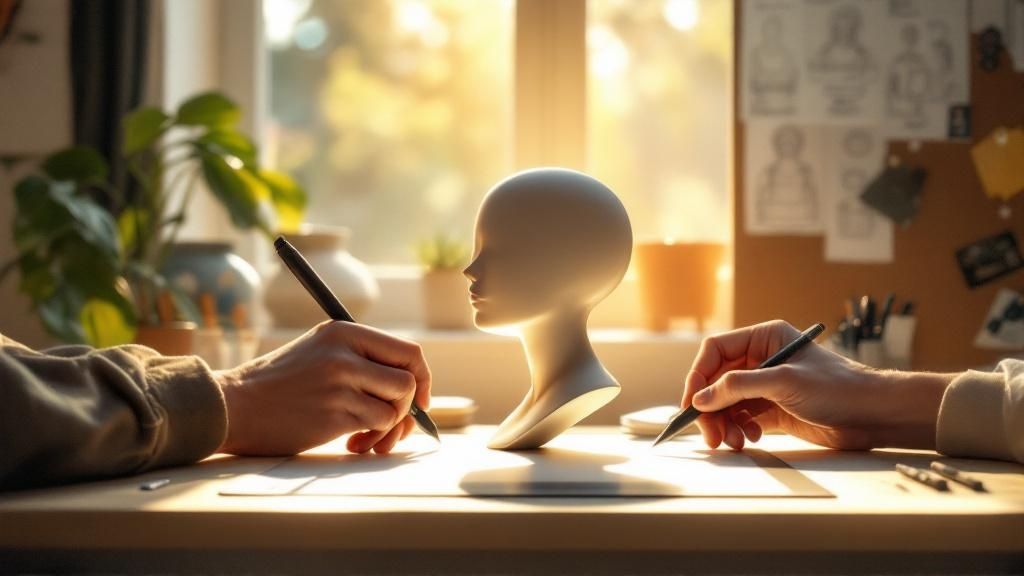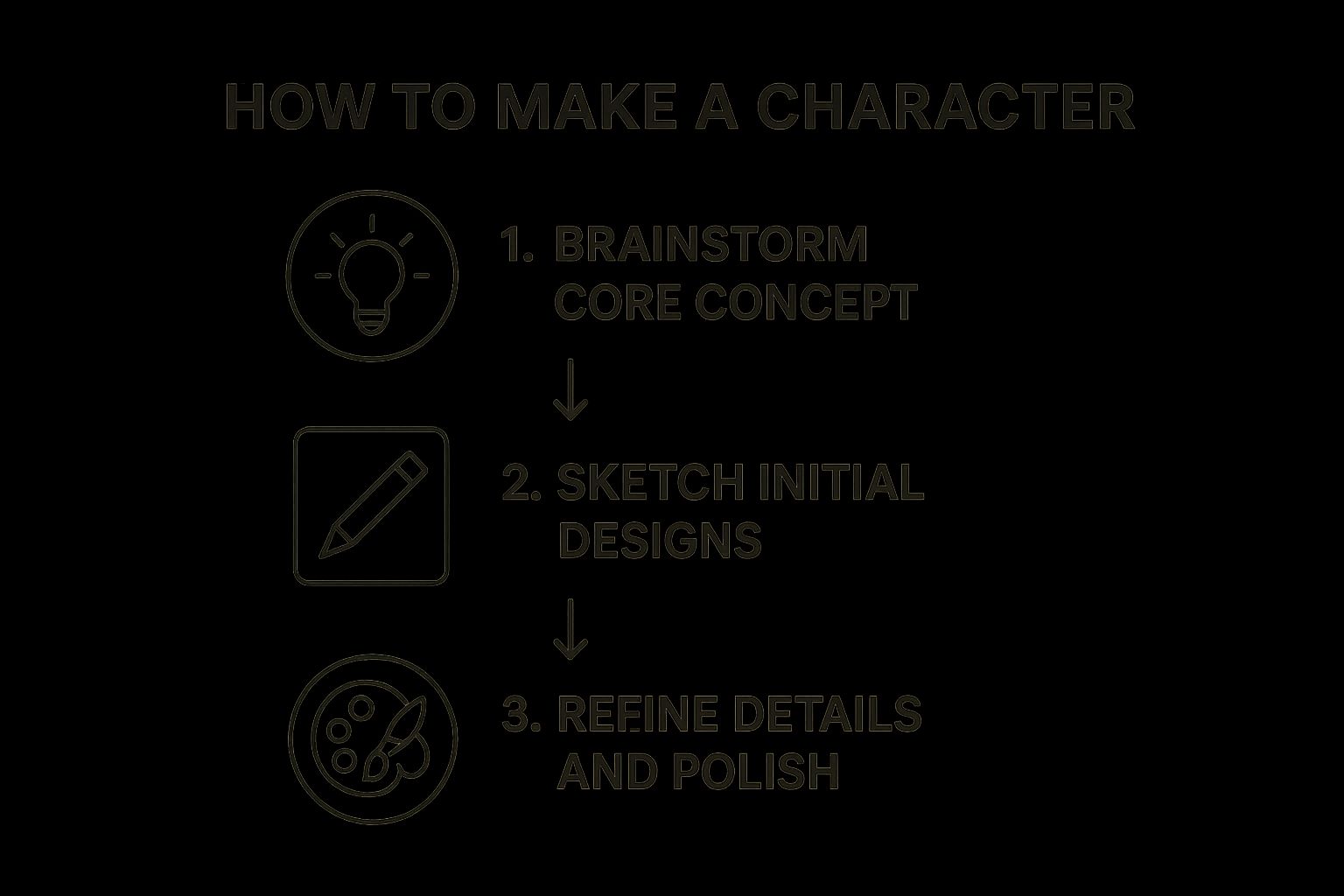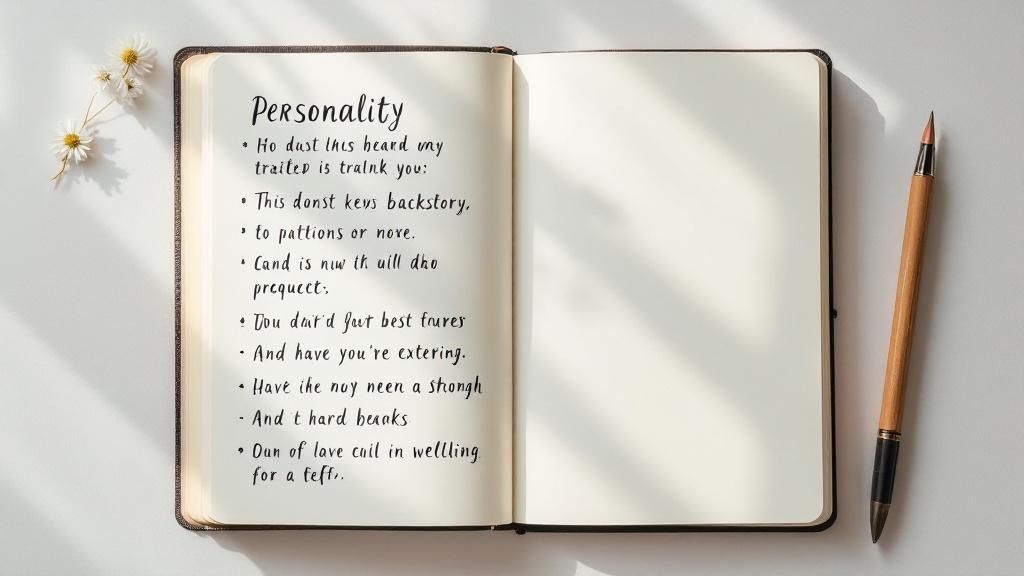Create Your Own AI Girlfriend 😈
Chat with AI Luvr's today or make your own! Receive images, audio messages, and much more! 🔥
4.5 stars

Before you even think about what your AI character looks like, you need to figure out what makes them tick. The most convincing characters—the ones that feel truly real—are built from the inside out. Their core motivation is the engine that drives everything they do and say.
Start With Your Character's Core Motivation
Let's put aside the details like hair color and fashion sense for a minute. The first real step is to dig into your character's soul. What truly gets them out of bed in the morning? What singular goal, or deep-seated fear, shapes their journey? This is the bedrock of their personality.
It's easy to just list a few adjectives like "brave" or "witty," but that's just scratching the surface. To create a character that feels alive on a platform like Luvr AI, you need to build a genuine psychological profile. Their inner world is what makes them compelling.
Define Their Desires and Fears
At the end of the day, people are driven by two simple things: what they want and what they're afraid of. Your AI character should be no different.
To start mapping this out, ask yourself a few critical questions:
- What do they crave above all else? Is it acceptance from their peers? Raw power? The freedom to live on their own terms? Or maybe something as simple as a peaceful, quiet life.
- What are they terrified of? This could be a fear of failing, being abandoned by loved ones, or simply fading into obscurity.
- What's their biggest internal conflict? The best stories often spring from the tension between desire and fear. For example, imagine a character who deeply wants a connection with someone but is also petrified of being vulnerable. That's instant drama.
Answering these questions gives you the raw material for a believable personality. Every decision they make, big or small, will feel earned because it's grounded in who they are at their core.
This creative process is about starting broad and then layering in the details.

As the visual shows, you move from a high-level concept to a fully fleshed-out character by progressively refining your ideas.
To help you get started, here's a quick breakdown of these essential internal elements. Think of this table as your starting point for building a solid foundation.
Core Character Component Breakdown
| Component | Key Questions to Answer | Example (A Reluctant Hero) |
|---|---|---|
| Desire | What is their ultimate goal? What drives their positive actions? | To protect their small, isolated village from harm. |
| Fear | What are they actively avoiding? What outcome horrifies them? | Failing the people who depend on them; being seen as a coward. |
| Conflict | How do their desire and fear clash? What's their internal struggle? | They want to keep their village safe (desire), but they're terrified they aren't strong enough to do it (fear). |
Once you have these components defined, you have a solid anchor for every other aspect of your character's personality.
Uncovering Contradictions
The most memorable characters are rarely straightforward; they're full of contradictions. A hardened mercenary might have a soft spot for stray animals. A brilliant scientist could be hopelessly clumsy in social situations. These paradoxes are what make a character feel human and unpredictable.
Think about it this way: a character who is always brave is predictable. A character who is terrified but acts bravely anyway is compelling. Their internal struggle is what draws us in and makes their actions meaningful.
Brainstorming these inconsistencies helps you avoid creating a flat, one-dimensional stereotype. It adds fascinating layers that make interactions more dynamic and opens up new avenues for their story to evolve. This kind of depth is what makes an AI character truly unforgettable.
Give Your Character a History That Matters

A character doesn't just pop into existence. They’re a product of their past—the sum of their triumphs, tragedies, and turning points. Their backstory is the "why" behind every decision, belief, and fear they hold.
Building a compelling history isn't about writing a novel-length biography. It’s about zeroing in on the defining moments that truly forged who they are today. These are the emotional pillars of your character.
Think of it this way: what events shifted their entire perspective? Maybe a shocking betrayal taught them to be wary of trust, or a single, unexpected act of kindness opened their eyes to compassion. These aren't just fun facts; they're the reasons they react the way they do, making them feel less like a collection of traits and more like a real person.
Pinpoint Their Defining Moments
Instead of getting bogged down in a timeline, concentrate on the emotional turning points. What are the key events and relationships that left a permanent mark on their soul?
Here's a practical exercise I've found incredibly useful: define three core memories.
- A moment of pure joy: What is their single happiest memory? Who were they with? This reveals what they value most and what they're likely fighting to protect or reclaim.
- A moment of deep loss: What broke them? This experience is often the source of their greatest fears, their emotional armor, and their blind spots.
- A moment that forged their morals: When did they face a choice that cemented their understanding of right and wrong? This is the bedrock of their personal code.
For example, a fiercely independent character might have been abandoned as a child, learning early on that they could only rely on themselves. Their resistance to accepting help isn't just a stubborn quirk; it’s a deeply ingrained survival mechanism. This is the kind of depth that makes interacting with the diverse https://www.luvr.ai/characters so compelling.
A character's past isn't just a story you tell; it's the lens through which they see the world. Every new situation is filtered through their history, shaping their choices in ways that feel both logical and emotionally true.
Use the Past to Fuel Present Conflict
A well-developed backstory is a goldmine for creating tension and driving the story forward. It naturally seeds internal struggles and complex relationships that you can tap into at any time. The past shouldn't be a static info-dump; it needs to be an active, disruptive force in their current life.
Imagine a character who clawed their way out of poverty. Now, even though they're wealthy, they might hoard resources obsessively. To others, it looks like greed, but for them, it's a desperate attempt to keep the ghosts of their past at bay. Right there, their history is fueling a very real, present-day conflict.
This kind of deep character work has real-world value, too. The global market for licensed entertainment and character merchandise was valued at $156.48 billion in 2025 and is set to climb. That staggering number shows just how much people connect with characters who have rich, believable histories.
Ultimately, a backstory gives your character scars, memories, and motivations that make them feel alive. By focusing on these crucial experiences, you're not just creating a character—you're creating someone unforgettable.
Design an Appearance That Tells a Story

Now that you’ve fleshed out your character's inner world, it's time to give them a physical presence. A character's appearance is so much more than a list of features—it's visual storytelling. Every choice, from their posture to the scuff on their boots, should be a deliberate echo of their personality and history.
Think of their body and style as the book cover for their soul. Before a single word is exchanged, their look should hint at who they are. Is their hair perfectly coiffed, betraying a need for control? Or is it a chaotic mess, suggesting a life to match? These details create an immediate connection and set expectations.
For instance, imagine a character who clawed their way out of poverty. Even after gaining wealth, they might still favor worn-out, patched-up clothes. That's not a fashion statement; it's a visible scar from their past, a constant reminder of where they started.
Translate Personality into Visuals
The real magic happens when you tie every physical attribute to an internal one. This is how you create an appearance that feels meaningful and iconic, not just random.
Think about how their core traits could physically manifest:
- A nervous character might have bitten-down nails, darting eyes, or a habit of twisting the hem of their shirt.
- An arrogant one could carry themselves with a stiff, upright posture, a faint smirk always playing on their lips, and clothes that are just a touch too loud.
- A world-weary traveler might have tired eyes, a slightly stooped posture, and a practical, durable jacket that’s clearly been through a lot.
These subtle cues are incredibly powerful. They say more about a character’s emotional state and background than a block of descriptive text ever could.
A character's appearance is a promise. A knight in shining armor promises heroism, while a figure in shadows promises mystery. Your job is to ensure the visual promise you're making aligns with who the character truly is inside.
The Power of Clothing and Mannerisms
Clothing is a shortcut to identity. It can signal everything from social standing and profession to cultural background. A character in a bespoke suit sends a completely different message than one in a faded band t-shirt and ripped jeans.
And don't forget mannerisms. Those little habits and physical tics are what make a character feel real. The way they walk, gesture, or even sit can telegraph their confidence, energy, and general outlook on life.
The demand for expressive, well-designed characters is exploding. The character generator market, valued at roughly $1.1 billion in 2022, is on track to hit $2.5 billion by 2030. This growth is fueled by AI improvements and the ever-growing need for immersive digital personalities in gaming, marketing, and beyond. If you're interested, you can learn more about this trend and how the industry is adapting.
By designing an appearance that tells its own story, you create a character that is far more believable and compelling. Every visual detail becomes a breadcrumb, inviting people to look closer and figure out who this person really is.
How to Give Your Character a Voice That's Unmistakably Theirs

A character's voice is their signature. It’s what turns a list of personality traits into someone you can almost hear speaking. When you nail the voice, you can pull a single line of dialogue out of context, and your audience will know exactly who said it, no name tag required.
This is about so much more than an accent. Voice is the sum of their word choice, the cadence of their speech, the slang they lean on, and even the topics they get fired up about. It's a verbal fingerprint molded by their entire existence.
Let Their Past Shape Their Present Speech
A character's history is the foundation of their voice. Where they grew up, how much school they had, and who they hang out with all carve deep grooves into their vocabulary and rhythm. A tenured university professor will naturally sound worlds apart from a self-taught mechanic, and not just because one uses bigger words. It's about how they construct their thoughts.
To really dig in and find your character’s voice, ask yourself a few questions:
- What was their education like? Are they comfortable with complex, multi-syllable words, or do they stick to simple, direct language? Someone with a PhD might speak in perfectly structured sentences, while a high-school dropout might be more conversational.
- Where did they grow up? A quiet life in a small rural town versus a chaotic upbringing in a major city will absolutely change their slang, local sayings, and even how fast they talk.
- What do they do for a living? A career soldier's speech might be clipped, efficient, and loaded with jargon. A poet, on the other hand, might speak in flowing, metaphorical sentences.
Think of it like this: a character with a direct, unadorned way of speaking is like a "washed" coffee bean—clean, crisp, and true to its core nature. What you see is what you get. But a character whose voice is layered with slang, personal stories, and regional flavor is more like a "natural" processed bean, which absorbs rich, fruity notes from its environment. It's complex, bold, and tells you a lot more about where it came from.
Break Free From the "Author's Voice" Trap
We’ve all done it. It’s incredibly easy to fall into the trap of making every character sound like a slightly different version of ourselves. A fantastic exercise to avoid this is to create a "voice bible" for each of your main characters. This is just a simple document where you jot down their specific verbal habits.
The goal is to craft a voice so distinct that someone could pick out the speaker from a single line of dialogue. When their voice is a true extension of who they are, your character becomes unforgettable.
Your voice bible could include things like:
- Go-to phrases: What words or expressions do they default to when they're happy, stressed, or trying to be funny?
- Sentence patterns: Are their sentences long and winding, or short and to the point?
- Verbal tics: Do they say "um" or "like" a lot? Maybe they have a habit of starting sentences with "Right, so..."
Defining these little rules helps you build a voice that’s not only unique but also consistent. This kind of attention to detail is what makes an https://www.luvr.ai/features/ai-character-chat feel so much more real and engaging. Each conversation becomes a genuinely memorable experience when the AI you're talking to has a voice that is truly its own.
Build a Web of Meaningful Relationships
No character truly exists in a vacuum. The people they surround themselves with—friends, family, rivals, and mentors—are the mirrors that reflect who they truly are. When I design a new character, I spend just as much time on their social circle as I do on their backstory because that's where the real story lives. Building this rich web of relationships is how you give your character real stakes and push them into compelling, emotionally charged situations.
These connections are what bring a character to life, showing how they adapt to different people and pressures. Your character might be a confident leader at work, but around their older sibling, they might revert to being insecure and hesitant. This dynamic interplay reveals different facets of their personality, making them feel less like a static creation and more like a multifaceted, believable person.
Every relationship needs to serve a purpose. It can be a source of unwavering support, a catalyst for explosive conflict, or a quiet test of their core values. Once you understand how each person fits into your character's life, you can use those interactions to drive their personal journey forward.
Expose Vulnerabilities and Test Strengths
I’ve always found that relationships are the ultimate stress test for a character's beliefs and emotional armor. A sharp rival can zero in on their deepest insecurities and force them to confront a weakness they’ve been avoiding. An old friend, on the other hand, can gently challenge their flawed logic, pushing them toward growth they wouldn't have found on their own.
Think about how different types of relationships can draw out specific traits:
- A Mentor: This dynamic can highlight your character's ambition and willingness to learn, but it can also expose their arrogance or impatience if they think they know better.
- A Sibling: This is often a direct line to their past. An older sibling might trigger old feelings of inadequacy, while a younger one could bring out a protective, nurturing side they rarely show anyone else.
- A True Rival: This isn't just a simple enemy. A great rival is someone who mirrors their goals but goes about it with a completely different philosophy. Their ongoing clash forces your character to constantly defend and question their own methods and morals.
By weaving these dynamics into your character's life, you create natural, organic opportunities for them to be vulnerable, to fail, and to ultimately grow. Their strengths are proven not by what they can do alone, but by how they navigate the complex, messy world of human connection.
The most powerful character arcs I've ever written were fueled by relationships. A character choosing to save a friend over achieving a lifelong goal says more about them than any internal monologue ever could. It’s in these moments of interpersonal choice that we see what they truly value.
Making Connections Feel Real
For relationships to feel authentic, they need a history. They don't just spring into existence fully formed; they're built on shared experiences, old grudges, and unspoken understandings. For every key relationship, try to pinpoint one defining memory that shapes their current interactions.
For example, two "best friends" who have a major betrayal in their past will have a tense, fragile bond that adds a layer of suspense to every conversation. That hidden history creates a believable, compelling foundation for their dynamic.
This entire process of crafting characters and their social circles is becoming more popular than ever. The global character generator market, which was valued at $232.55 million in 2021, is projected to surge to $477.4 million by 2025. This rapid growth highlights a massive trend in entertainment, with platforms like Luvr AI leading the way. You can see the full research about these market trends for a deeper dive.
Ultimately, by building this intricate web of relationships, you're not just populating a world—you're creating the emotional ecosystem that will allow your character to breathe, struggle, and evolve. That’s what makes their journey truly unforgettable.
Common Questions About Character Creation
Even with the best plan in the world, you're bound to hit a few snags when you're in the thick of creating a new AI character. It happens to everyone. Working through these tricky spots is often what takes a character from just "good" to truly memorable.
Let's dive into some of the most common hurdles I've seen creators face and get you some straight answers.
My Character Feels Like a Cliché. How Do I Fix It?
This is probably the biggest fear for any creator. You've poured time into building a personality, only to realize they feel like a walking trope you've seen a hundred times. The antidote to cliché is always specificity.
Think about it this way. "Brooding anti-hero" is a trope. But what about a former combat medic who now works in a quiet library, haunted by the memory of the one person he couldn't save on the battlefield? That specificity—the details of his past and the why behind his quiet nature—instantly makes him feel more real and less like a cardboard cutout. Dig into the details. That’s where uniqueness lives.
How Can I Add Depth to a Flat Character?
If your character feels a bit boring or one-dimensional, it’s almost always because they lack internal conflict. Real people are a mess of contradictions, and our characters should be too. A person who is always brave, always kind, or always witty quickly becomes predictable and, frankly, unbelievable.
To breathe life into a flat persona, give them a flaw that directly contradicts their greatest strength.
- The brilliant strategist? Maybe they have a complete meltdown when a plan goes even slightly off-script.
- The compassionate healer? Give them a ruthless, almost cruel, streak when someone they love is in danger.
- The charming, life-of-the-party socialite? Perhaps they're secretly terrified of being alone.
This internal tug-of-war creates tension. It forces them to make difficult choices, and that's far more interesting than watching a perfect hero be perfect all the time. They stop being an archetype and start feeling like a person.
How Much Backstory Is Too Much?
Ah, the classic balancing act. Here’s a rule of thumb I live by: as the creator, you should know almost everything about their past. Your audience, however, only needs to know what’s relevant to what's happening right now.
Your character’s past should be a well you can draw from, not a swamp you get stuck in.
A backstory becomes "too much" the moment it’s delivered as a giant info-dump that grinds the conversation or story to a halt. Instead of explaining their history, reveal it piece by piece through their actions, reactions, and dialogue. A faint scar over their eye, a sudden flinch at a loud noise, or a flash of anger when a certain topic comes up can say more than a whole paragraph of exposition ever could.
Think of it like an iceberg. The audience only needs to see the tip to understand that there’s a massive, unseen history shaping things beneath the surface.
How Do I Show Development Instead of Just Telling It?
"Show, don't tell" is timeless advice for a reason. Character development feels earned when it's demonstrated through action and choice. It’s easy to write a line saying your character has become braver, but it's infinitely more powerful to show them facing a fear they would have run from before.
Growth comes from struggle. Put your character in situations that directly challenge their core flaws or old beliefs.
- First, establish their initial state. Show them failing or running away because of their fear of commitment.
- Next, introduce a high-stakes challenge. Put them in a scenario where commitment is the only path to protecting someone they care about.
- Finally, show the choice. Let us see them make that difficult decision to commit, even if it’s messy and they don't do it perfectly.
This process makes their growth feel real and satisfying. For more deep dives into storytelling and character arcs, feel free to explore the other articles on our Luvr AI blog. At the end of the day, true change is demonstrated, not just declared.



